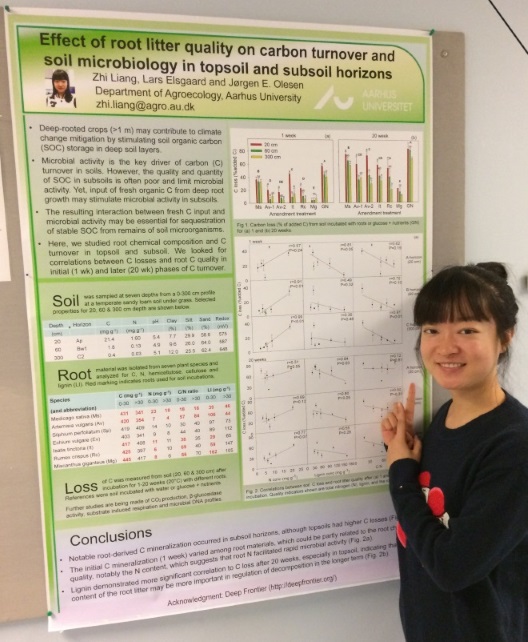Promising results about carbon turnover in deep soil
Preliminary results about carbon turnover in top- and subsoil were presented at a recent symposium. The poster, which was prepared by Zhi Liang, Ph.D.-student of the Deep Frontier project, won the prize for ‘Best poster’.
How can we exploit subsoil resources for food production and how can we mitigate climate change? These are some of the questions, which the Deep Frontier project, is trying to answer. Preliminary results carried out in Foulum, Aarhus University, indicate that this area of research is worth investigating further.
Root decomposition and influencing factors in different soil depths
Ph.D.-student Zhi Liang of Aarhus University is, as part of her Ph.D.-thesis, looking into effect of root chemistry on carbon turnover in the deep soil layers compared to topsoil.
- The overall aim is to investigate how we can use deep rooted crops to improve carbon storage in subsoil where turnover of soil organic carbon is generally slower than in topsoil. If we can find some key factors related to root decomposition, then we may be able to find suitable crops and management options that are beneficial for stimulating carbon storage, explains Zhi Liang.
In her part of the study root material was isolated from seven different plant species (see poster for details), and analyzed for carbon, nitrogen, hemicellulose, cellulose and lignin. Soil samples were collected from seven depths between 0-300 centimeters of which data from 20, 60 and 300 centimeters showed the most interesting results. The concentration of carbon and nitrogen both decreased with increasing soil depths (see poster for details).
The importance of nitrogen and lignin concentrations in root biomass
Additionally, by using incubation methods, data for carbon loss was collected over time and the most significant observations were found when comparing 1 week with data obtained after 20 weeks. After 1 week there was a significant positive correlation with nitrogen concentration at 60 and 300 cm, and after 20 weeks there was a similar pattern, although only significant at 300 centimeters. However, it seems that lignin is becoming a more important factor in root carbon loss after 20 weeks, as there was a significant negative correlation between lignin concentration and carbon loss at 20 and 60 centimeters.
- These are interesting findings in the case study, which show the important factors for root carbon storage in subsoil. Also, I can see that more people are becoming interested in this field of research. It is a promising field.
- The roots of current annual crops usually cannot reach deeper than 1-1.2 meters, but with perennial crops that are not harvested every year and that can grow long roots into the deeper subsoil, we may find the best way of using the resources of subsoil and contributing to climate change mitigation, explains Zhi Liang.
More results from the project are on their way and a paper based on these preliminary results is in preparation.

Zhi Liang is showing the ‘Best poster’: “It was a big surprise winning ‘Best poster’ at the Symposium. It is an interesting topic and I’m proud of my Ph.D.-project. For two years, I have worked on it and I will submit my thesis in October next year. So one year to go and I hope for more interesting results”.
Become familiar with the findings of the project in Organic eprints:
Read more about the project:
Read more about the Symposium:
***
This project is funded by Villum Fonden and coordinated by ICROFS. Project partners are University of Copenhagen, University of Aarhus and ICROFS.